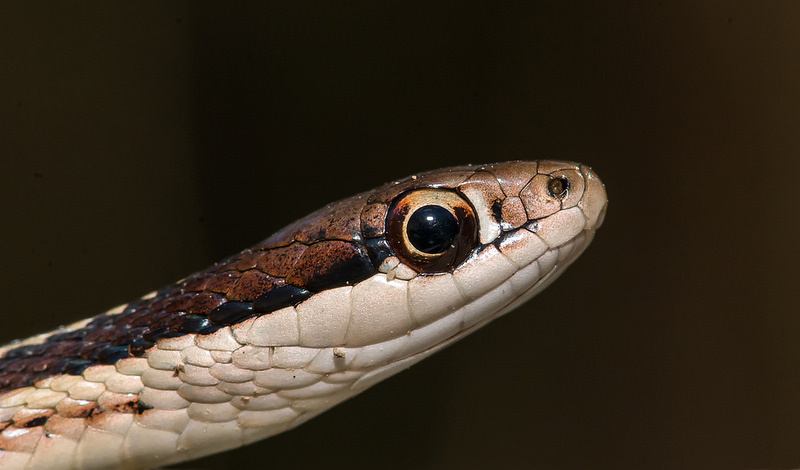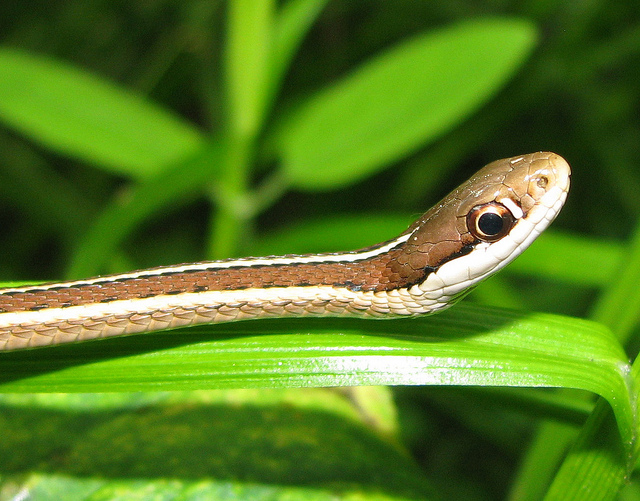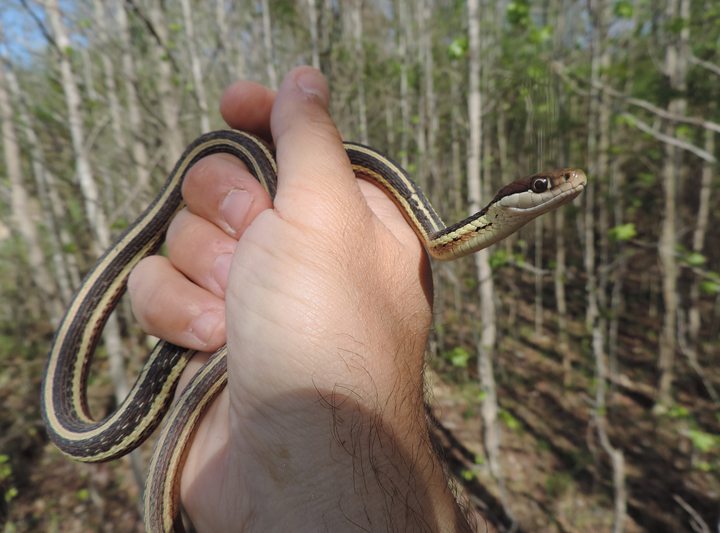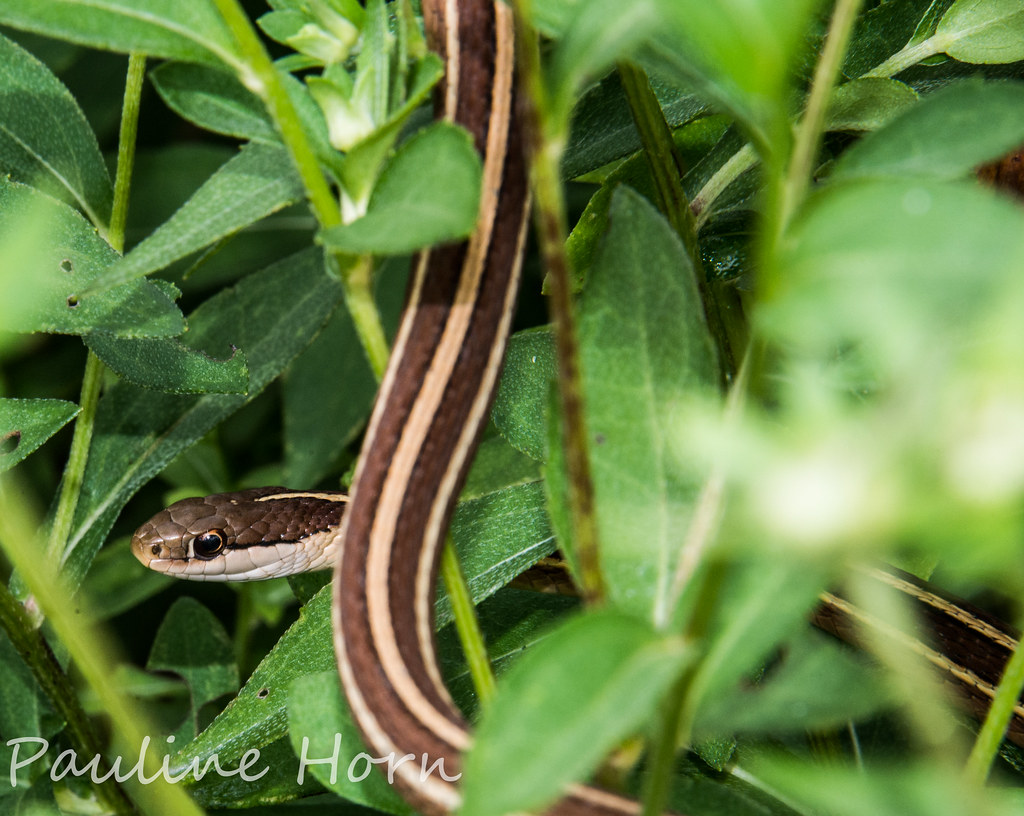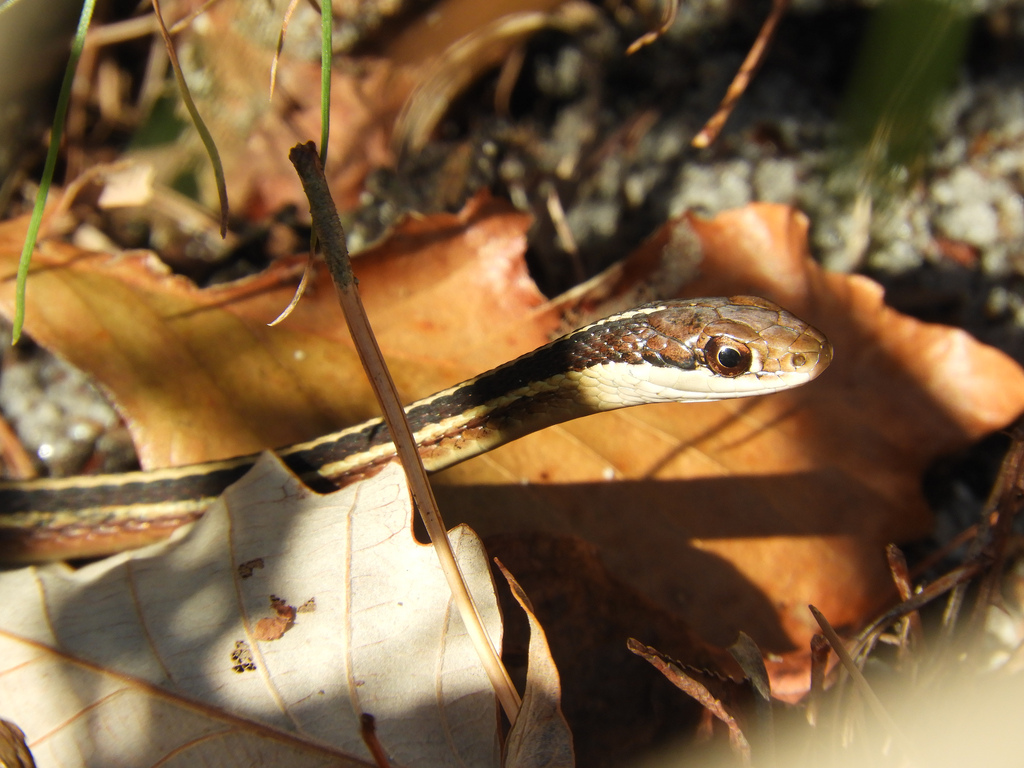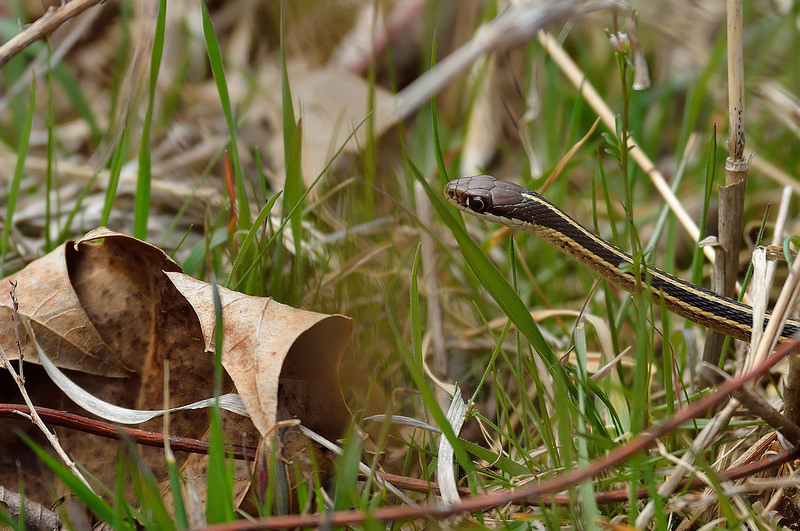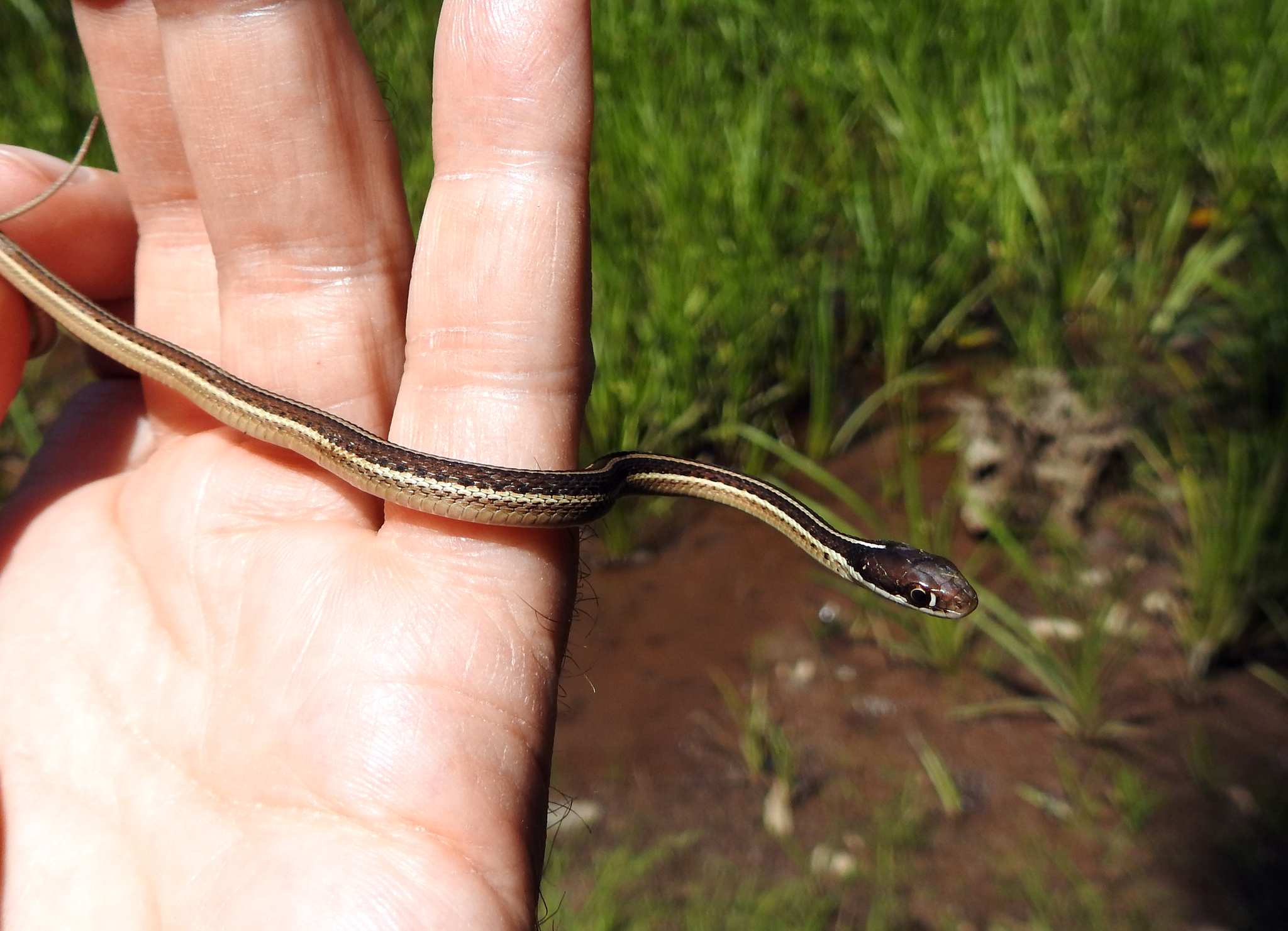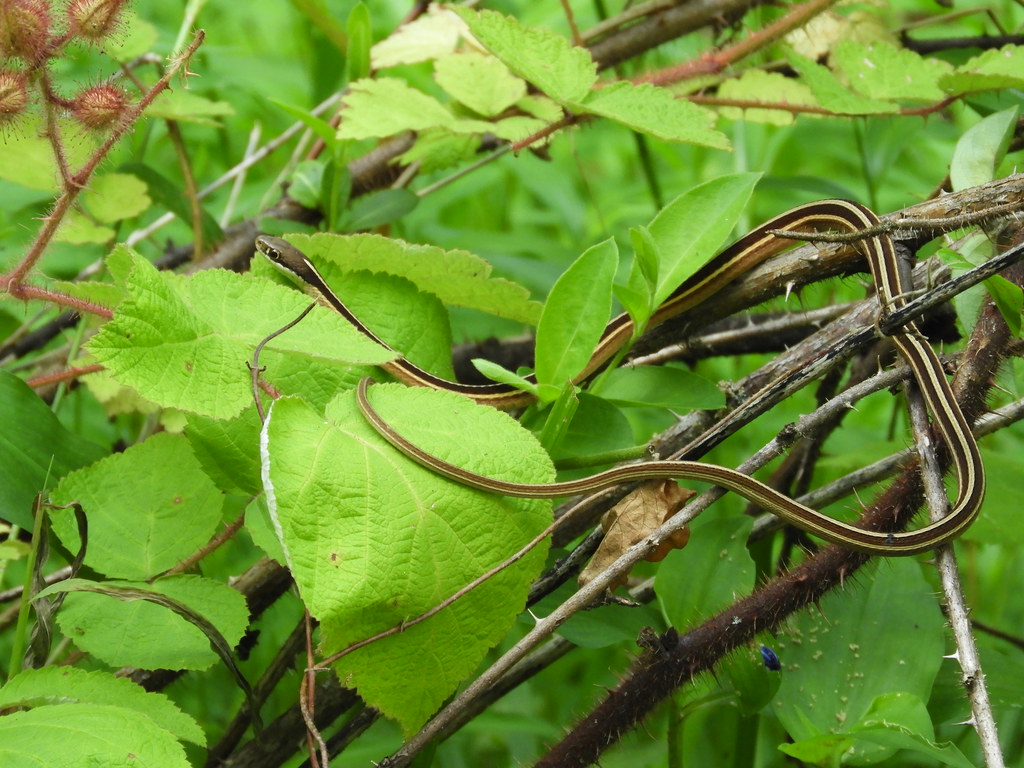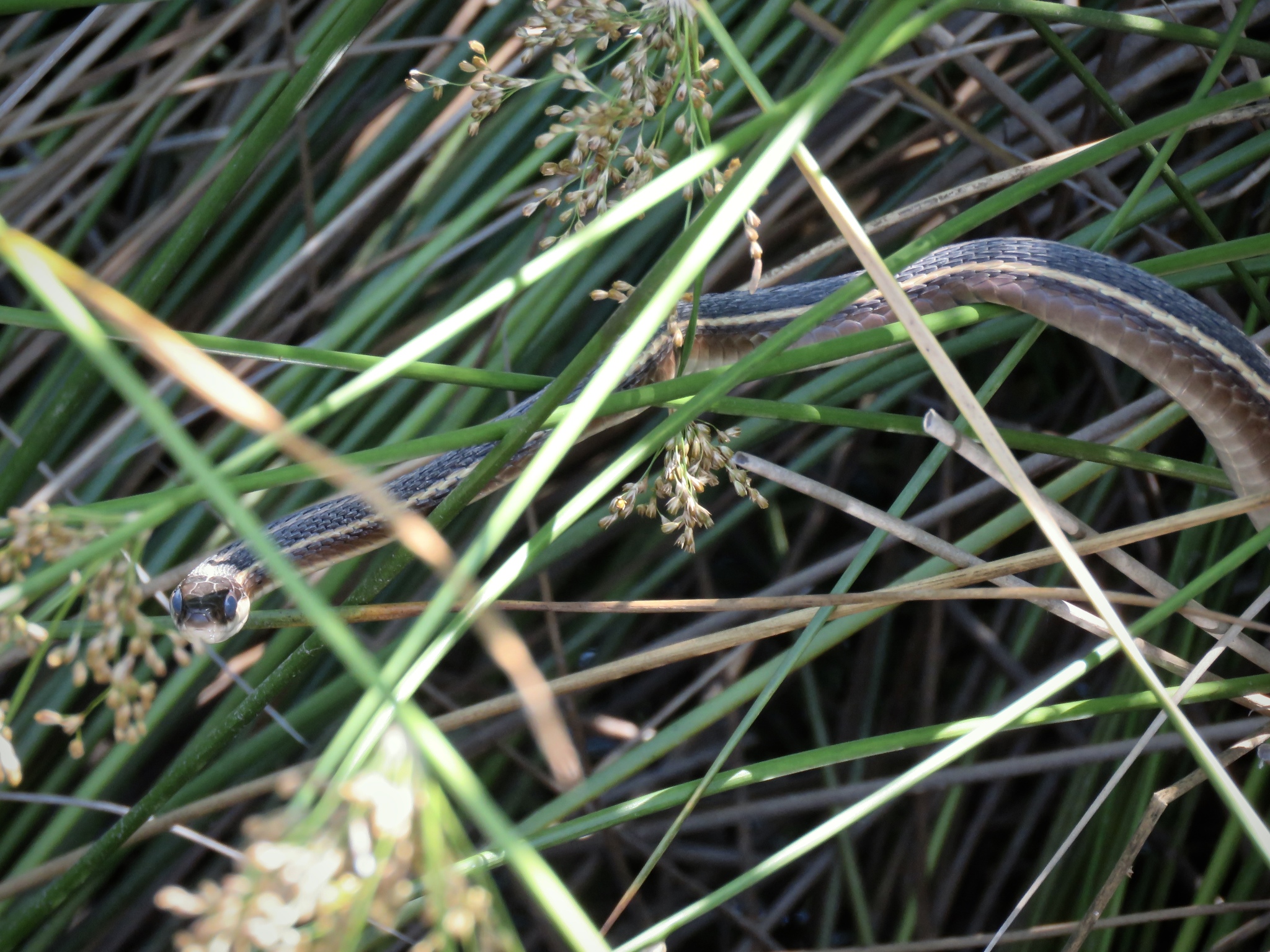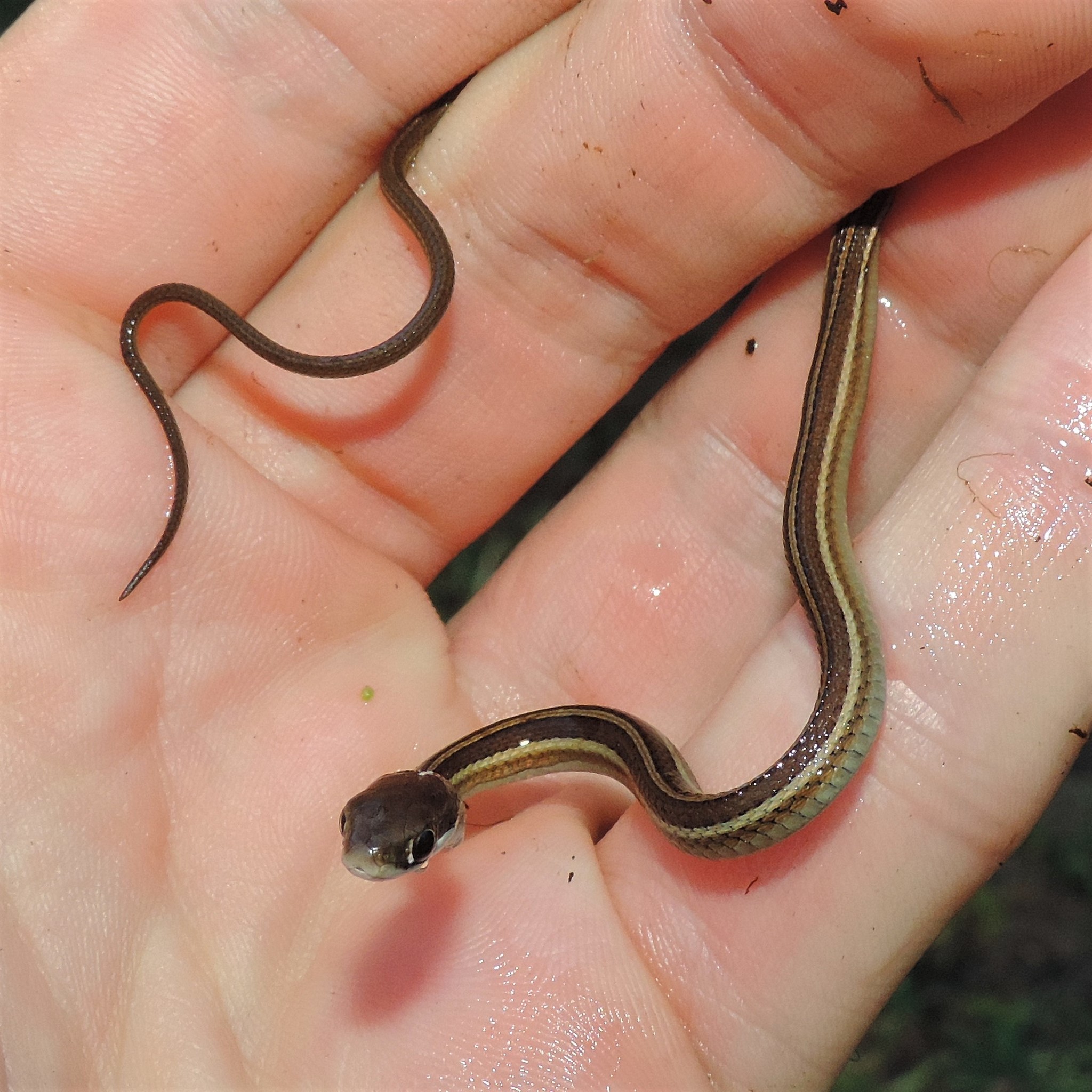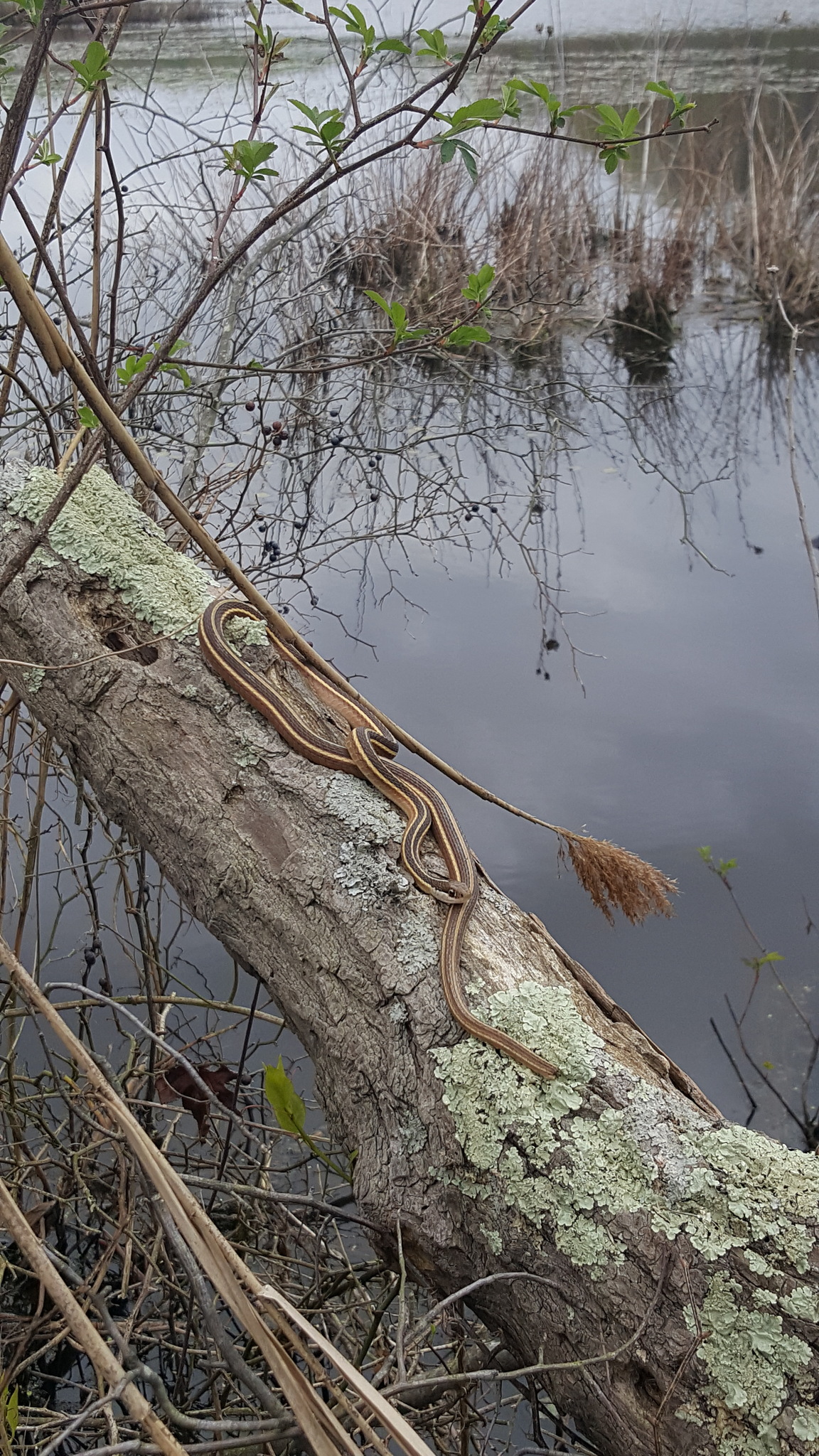Map Snapshot























169 Records
Status
Eastern Ribbonsnake (Thamnophis saurita) is a semi-aquatic garter snake tends to be found along vegetated pond or lake edges, around vernal pools, or in marshes, swamps, or wet meadows. It is closely associated with margins of wetlands, where it usually hunts small fish or amphibians, especially anurans (Tennant, 2003). In Maryland, Eastern Ribbonsnake is distributed statewide, but appears to be less common in western Maryland (Maryland DNR).
Description
Eastern Ribbonsnake (Thamnophis saurita) can be distinguished from the ubiquitous Common Gartersnake by its more slender body shape and proportionately longer tail (29.8-38.8% of total BL). Ribbonsnakes show a distinctive pale patch on the preocular scale, anterior to the eyes, and lack dark sutural markings on the labial scales. There is a maximum of 19 total dorsal scale rows, and the lateral stripes occupy dorsal scale rows 3-4 on each side (Rossman et al., 1996).
Seasonality Snapshot
Source: Wikipedia
| Thamnophis saurita | |
|---|---|

| |
| Eastern ribbon snake (Thamnophis saurita) | |
| Scientific classification | |
| Domain: | Eukaryota |
| Kingdom: | Animalia |
| Phylum: | Chordata |
| Class: | Reptilia |
| Order: | Squamata |
| Suborder: | Serpentes |
| Family: | Colubridae |
| Genus: | Thamnophis |
| Species: | T. saurita
|
| Binomial name | |
| Thamnophis saurita | |
| Subspecies | |
|
Four, see text | |
| Synonyms[2][3][4] | |
Thamnophis saurita, also known as the eastern ribbon snake[a], common ribbon snake, or simply ribbon snake, is a common species of garter snake native to Eastern North America.[2] It is a non-venomous[5][6] species of snake in the subfamily Natricinae of the family Colubridae. The ribbon snake averages 16 to 35 inches (41 to 89 cm) in total length (including tail).[7] It is dark brown with bright yellow stripes.[8] The ribbon snake is not sexually dimorphic; however, females are normally thicker than their male counterparts.
The ribbon snake can be found in wet climates such as lakes, streams, ponds and marshes. The ribbon snake is active from April to October and hibernates during the winter months. Maturity is reached around 3 years of age.[8]
Subspecies
[edit]The following four subspecies of ribbon snake are recognized as being valid:[2]
- Eastern ribbon snake – T. s. saurita (Linnaeus, 1766) – brown body with three distinctive stripes, typically yellow, one down the middle of the back and one down each side, that alternate with the brown body.[9] Ranges from New York to Florida, west to the Mississippi River.
- Northern ribbon snake – T. s. septentrionalis Rossman, 1963 – dark brown/black with yellow line down its back and often its sides; ranges from Maine through Ontario and Indiana.
- Southern ribbon snake or peninsula ribbon snake – T. s. sackenii (Kennicott, 1859) – tan or brown; ranges from South Carolina south through Florida.
- Bluestripe ribbon snake – T. s. nitae Rossman, 1963 – dark with light blue lateral stripes; Gulf Coast of north-central Florida.
Nota bene: A trinomial authority in parentheses indicates that the subspecies was originally described in a genus other than Thamnophis.
Habitat
[edit]Ribbon snakes are semi-aquatic and are seldom found far from water. This species can be seen basking or resting along ponds, streams, swamps, and wet woodlands or grasslands. Shallow water is exploited both as hunting grounds and an escape route from predators. Overwintering sites are typically underground at higher elevations, such as under rock piles.[10]
Prey and predators
[edit]In order to hunt, ribbon snakes use a few of their senses including auditory and visual perception. Ribbon snakes do not eat warm-blooded prey, just as garter snakes, also of the genus Thamnophis, do not. Using their auditory and visual traits, they are able to prey upon newts, salamanders, frogs, toads, tadpoles, small fish, spiders, and earthworms. Meanwhile, they fall prey to mammals, birds, and larger amphibians and reptiles.[11] Ribbon snakes rarely use any aggressive form of defense. Instead, they use their brown bodies to camouflage with the surrounding vegetation. Along with this, they flee and hide in dense patches of grass in which they will coil up and get as low to the ground as possible. Given that snakes consume their prey whole, small individuals are particularly constrained in the size and shape of prey that can be consumed. These smaller snakes compensate for their smaller body size by having larger heads.[12]
Reproduction
[edit]Beginning in the spring, after hibernation, ribbon snakes begin to look for another snake with which to mate. Ribbon snakes are ovoviviparous snakes, meaning they give birth to live young. The live young tend to be born in the summer, in litters of 4 to 27 snakes. Ribbon snakes tend to mature after two to three years, which is when they will be able to start breeding. Ribbon snakes tend to breed once or twice each year after they mature.[13]
Footnotes
[edit]- ^ Used as a species-level common name.[2] Not to be confused with the subspecies of the same name.
References
[edit]- ^ Hammerson, G.A. (2007). "Thamnophis sauritus". IUCN Red List of Threatened Species. 2007: e.T63991A12727431. doi:10.2305/IUCN.UK.2007.RLTS.T63991A12727431.en. Retrieved 29 July 2024.
- ^ a b c d e Thamnophis saurita, Reptile Database
- ^ Boulenger GA (1893). Catalogue of the Snakes in the British Museum (Natural History). Volume I., Containing the Families ... Colubridæ Aglyphæ, part. London: Trustees of the British Museum (Natural History). (Taylor and Francis, printers). xiii + 448 pp. + Plates I–XXVIII. (Tropidonotus saurita, pp. 212–214.)
- ^ Ruthven, Alexander G. (1908). "Variations and Genetic Relationships of the Garter-snakes". Bulletin of the United States National Museum (61): 1–201, 82 figures. doi:10.5479/si.03629236.61.1. hdl:2027/mdp.39015082586366. (Thamnophis sauritus, new combination, page 112).
- ^ "Eastern Ribbonsnake". 17 August 2020.
- ^ "Common Name".
- ^ Conant, Roger; Collins, Joseph T. (1998). A Field Guide to Reptiles & Amphibians: Eastern and Central North America. Houghton Mifflin Harcourt. ISBN 0-395-90452-8.
- ^ a b "Eastern Ribbon Snake Facts and Pictures | Reptile Fact". www.reptilefact.com. 10 April 2017. Retrieved 2018-10-22.
- ^ "Eastern ribbon snake videos, photos and facts - Thamnophis sauritus ". Arkive. Archived from the original on 2012-04-10. Retrieved 2018-11-12.
- ^ "Common Ribbonsnake" (PDF). ct.gov. Retrieved 2018-10-21.
- ^ "Scientific name: Thamnophis sauritus Common name: Ribbon Snake". Virtual Nature Trail at Penn State New Kensington. Pennsylvania State University. 2016. Retrieved 2018-10-30.
- ^ Hampton, Paul M. (2011). "Feeding performance in the Western Ribbon Snake (Thamnophis proximus): ontogeny and the effects of prey type and size". Canadian Journal of Zoology. 89 (10): 945–950. doi:10.1139/z11-072.
- ^ "Thamnophis sauritus (Eastern Ribbonsnake)". Animal Diversity Web. Retrieved 2018-10-22.
Further reading
[edit]- Conant, Roger; Bridges, William (1939). What Snake Is That? A Field Guide to Snakes of the United States East of the Rocky Mountains. (With 108 drawings by Edmond Malnate). New York and London: D. Appleton-Century Company. Frontispiece map + 163 pp. + Plates A–C, 1–32. (Thamnophis sauritus, pp. 121–124 + Plate 23, figures 68, 69B).
- Kraus, Fred; Cameron, H. Don (2016). "A note on the proper nomenclature for the snake currently known as Thamnophis sauritus ". Herpetological Review 47 (1): 74–75. (Thamnophis saurita, new combination).
- Linnaeus C (1766). Systema naturæ per regna tria naturæ, secundum classes, ordines, genera, species, cum characteribus, differentiis, synonymis, locis. Tomus I. Editio Duodecima, Reformata. Stockholm: L. Salvius. 532 pp. (Coluber saurita, new species, p. 385). (in Latin).
- Powell R, Conant R, Collins JT (2016). Peterson Field Guide to Reptiles and Amphibians of Eastern and Central North America, Fourth Edition. Boston and New York: Houghton Mifflin Harcourt. 494 pp., 47 plates, 207 figures. ISBN 978-0-544-12997-9. (Thamnophis sauritus, pp. 430–431 + Plate 43).
- Schmidt KP, Davis DD (1941). Field Book of Snakes of the United States and Canada. New York: G.P. Putnam's Sons. 365 pp., 34 plates, 103 figures. (Thamnophis sauritus, pp. 255–257 + Plate 28).
- Smith HM, Brodie ED Jr (1982). Reptiles of North America: A Guide to Field Identification. New York: Golden Press. 240 pp. ISBN 0-307-13666-3 (paperback), ISBN 0-307-47009-1 (hardcover). (Thamnophis sauritus, pp. 144-145).
- Wright AH, Wright AA (1957). Handbook of Snakes of the United States and Canada. Ithaca and London: Comstock Publishing Associates, a Division of Cornell University Press. 1,105 pp., 306 figures, 70 maps. (in 2 volumes). (Thamnophis sauritus, pp. 824–828, 831–834, Figures 239, 241 + Map 59 on p. 767).
- Zim HS, Smith HM (1956). Reptiles and Amphibians: A Guide to Familiar American Species: A Golden Nature Guide. New York: Simon and Schuster. 160 pp. (Thamnophis sauritus, pp. 105, 156).


